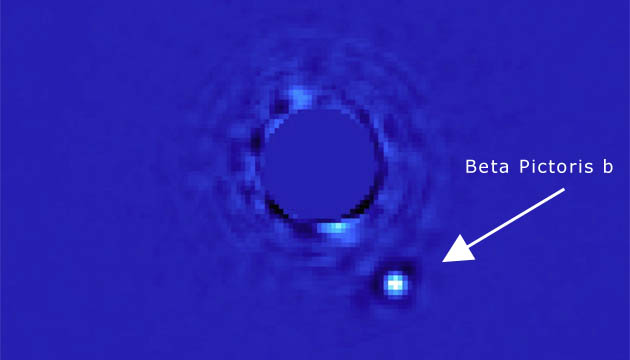
Recently, a major milestone in space exploration was reached: a planet was captured in a picture! That may not sound like a big deal; after all we’ve been enjoying beautiful, highly detailed color photography of planets—Mars, Jupiter, Saturn, and the rest—for a long time. The big deal is that the planet captured in this shot, a gas giant planet named Beta Pictoris b, is 63 light years away–over 100,000 times farther away than even Pluto.
The bigger deal, maybe, is that the instrument that captured Beta Pictoris b, the new Gemini Planet Imager (GPI), did so without working up a sweat. Not only was it the first picture that GPI ever took, as a practice shot, it snapped it in only a minute—a feat that would have taken previous instruments over an hour to accomplish.
GPI took this maiden-voyage picture (coined “first light” in the world of observational astronomy, when a new instrument is first exposed to photons from an object in space) last November. And though the planet Beta Pictoris b appears as a dot only a few pixels across, this is the best direct image of an exoplanet to date—and GPI’s capabilities go well beyond the production of images.
GPI is designed to reveal characteristics of its target planets like mass, composition, and even the material environment surrounding it. It is capable of detecting planets around Jupiter’s size orbiting their stars at distances between 5 and 40 Astronomical Units—a range that in our solar system spans the orbits of Jupiter to beyond Neptune. And of the over 1000 exoplanets currently known to exist, most of these are gas giants—exactly the type of planet GPI is designed to observe.
GPI is a currently operating at the Gemini South Observatory in Chile. It uses the technology of adaptive optics to remove the distortions created by Earth’s turbulent atmosphere, the age-old impediment to conventional ground-based telescopic observation. The heart of an adaptive optics system is a deformable, computer controlled mirror that adapts the shape of its surface to match waves of atmospheric turbulence, thus canceling them out—somewhat analogous to how noise-canceling headphones use samples of audio noise to cancel them out of what we are listening to.